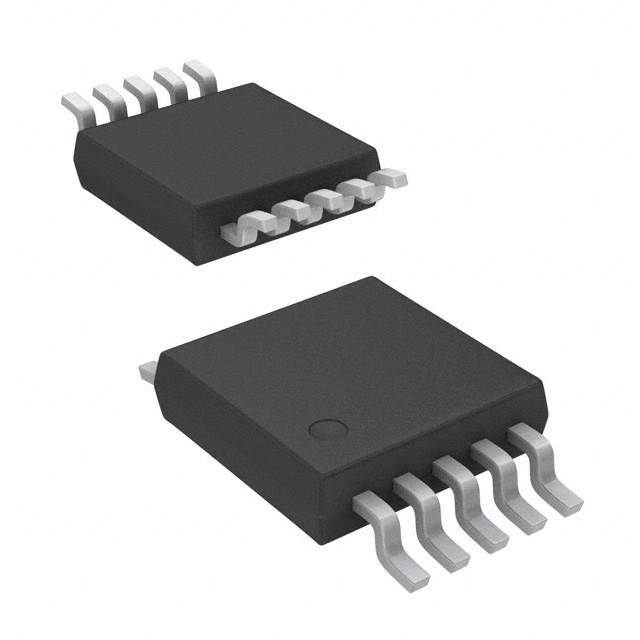Viz Specifikace pro podrobnosti o produktu.

AD7787BRMZ
Product Overview
Category
The AD7787BRMZ belongs to the category of analog-to-digital converters (ADCs).
Use
This product is primarily used for converting analog signals into digital data, making it suitable for a wide range of applications.
Characteristics
- High precision: The AD7787BRMZ offers high-resolution conversion, ensuring accurate and reliable results.
- Low power consumption: This ADC operates with low power requirements, making it energy-efficient.
- Small package size: The AD7787BRMZ comes in a compact package, allowing for easy integration into various systems.
- Wide input voltage range: It can handle a broad range of input voltages, providing flexibility in signal acquisition.
Package
The AD7787BRMZ is available in a miniature 10-lead MSOP (Micro Small Outline Package), which ensures space-saving installation.
Essence
The essence of the AD7787BRMZ lies in its ability to convert analog signals into digital format with high precision and low power consumption.
Packaging/Quantity
This product is typically packaged in reels or tubes, with a quantity of 250 units per reel/tube.
Specifications
- Resolution: 16 bits
- Input Voltage Range: ±Vref
- Conversion Rate: 20 samples per second
- Operating Temperature Range: -40°C to +85°C
- Supply Voltage: 2.7V to 5.25V
Detailed Pin Configuration
- VDD: Power supply voltage input
- VREF: Reference voltage input
- AGND: Analog ground
- AIN+: Positive analog input
- AIN-: Negative analog input
- DVDD: Digital power supply voltage input
- DOUT/RDY: Data output/Ready indicator
- SCLK: Serial clock input
- CS: Chip select input
- DGND: Digital ground
Functional Features
- High-resolution conversion: The AD7787BRMZ provides 16-bit resolution, ensuring accurate representation of analog signals.
- Low noise performance: This ADC minimizes noise interference, resulting in clean and reliable digital data.
- On-chip calibration: It features an integrated calibration function that compensates for any offset or gain errors, enhancing accuracy.
- Serial interface: The AD7787BRMZ utilizes a serial interface for easy communication with microcontrollers or other digital devices.
Advantages and Disadvantages
Advantages
- High precision conversion
- Low power consumption
- Compact package size
- Wide input voltage range
- Integrated calibration function
Disadvantages
- Limited conversion rate (20 samples per second)
- Requires an external reference voltage source
Working Principles
The AD7787BRMZ operates based on the principle of successive approximation. It samples the analog input signal, compares it to a reference voltage, and iteratively adjusts the digital output until the conversion is complete. The integrated calibration function ensures accurate results by compensating for any errors introduced during the conversion process.
Detailed Application Field Plans
The AD7787BRMZ finds applications in various fields, including but not limited to: 1. Industrial automation: Used for precise measurement and control in manufacturing processes. 2. Medical devices: Enables accurate data acquisition in medical equipment such as patient monitors and diagnostic instruments. 3. Instrumentation: Suitable for high-precision measurement instruments like multimeters and oscilloscopes. 4. Energy management: Helps monitor and optimize energy consumption in smart grid systems. 5. Automotive electronics: Used in automotive sensors and control systems for accurate signal processing.
Detailed and Complete Alternative Models
- AD7791: Similar to the AD7787BRMZ, this ADC offers 24-bit resolution and a higher conversion rate.
- ADS1115: A 16-bit ADC with an integrated programmable gain amplifier, suitable for low-power applications.
- MCP3421: This 18-bit ADC provides high-resolution conversion and operates at a low supply voltage.
These alternative models offer similar functionality to the AD7787BRMZ but may have different specifications or package options.
Word count: 550 words
Seznam 10 běžných otázek a odpovědí souvisejících s aplikací AD7787BRMZ v technických řešeních
Sure! Here are 10 common questions and answers related to the application of AD7787BRMZ in technical solutions:
Q: What is the AD7787BRMZ? A: The AD7787BRMZ is a high-precision, low-power, 24-bit analog-to-digital converter (ADC) designed for various applications.
Q: What is the input voltage range of the AD7787BRMZ? A: The AD7787BRMZ has a differential input voltage range of ±VREF/2, where VREF is the reference voltage supplied to the ADC.
Q: What is the resolution of the AD7787BRMZ? A: The AD7787BRMZ has a resolution of 24 bits, which means it can represent analog signals with very high precision.
Q: What is the maximum sampling rate of the AD7787BRMZ? A: The AD7787BRMZ has a maximum sampling rate of 16.7 kilosamples per second (ksps).
Q: Can the AD7787BRMZ operate with a single power supply? A: Yes, the AD7787BRMZ can operate with a single power supply ranging from 2.7V to 5.25V.
Q: Does the AD7787BRMZ have built-in digital filters? A: Yes, the AD7787BRMZ features an on-chip digital filter that can be configured to provide different filter responses.
Q: What is the interface used to communicate with the AD7787BRMZ? A: The AD7787BRMZ uses a serial peripheral interface (SPI) for communication with a microcontroller or other devices.
Q: Can the AD7787BRMZ be used in low-power applications? A: Yes, the AD7787BRMZ is designed for low-power operation and has a standby mode to further reduce power consumption.
Q: What are some typical applications of the AD7787BRMZ? A: The AD7787BRMZ is commonly used in industrial process control, weigh scales, medical instruments, and other precision measurement systems.
Q: Is the AD7787BRMZ available in a small form factor package? A: Yes, the AD7787BRMZ is available in a 10-lead MSOP (mini small outline package), which is compact and suitable for space-constrained designs.
Please note that these answers are general and may vary depending on specific requirements and use cases.

